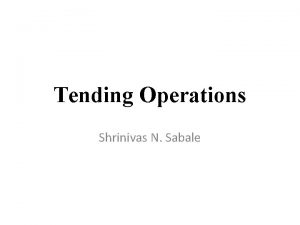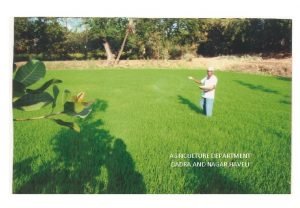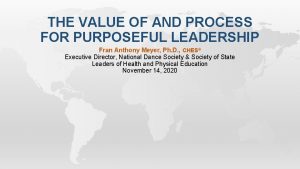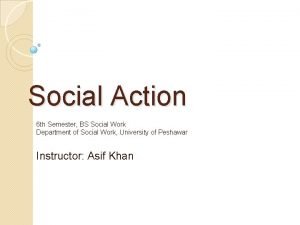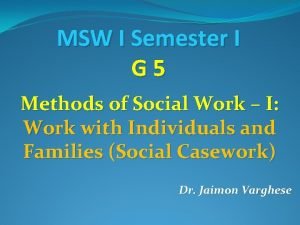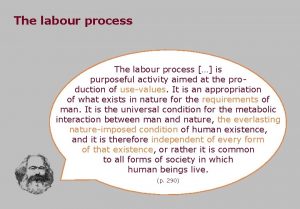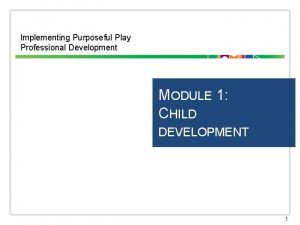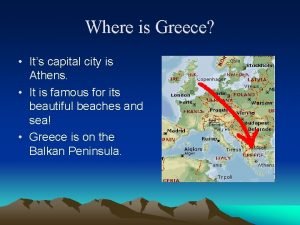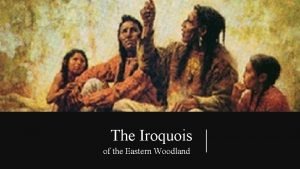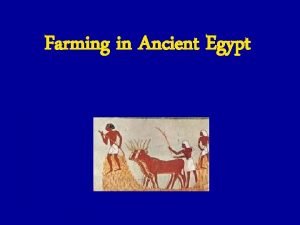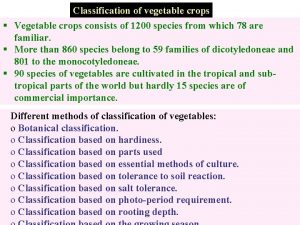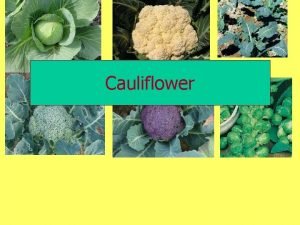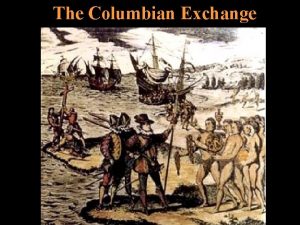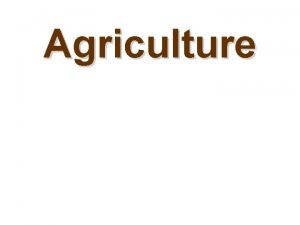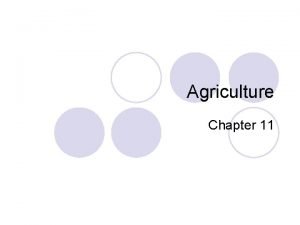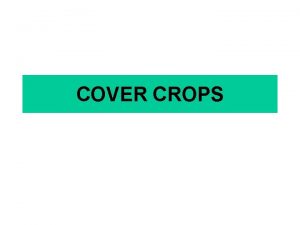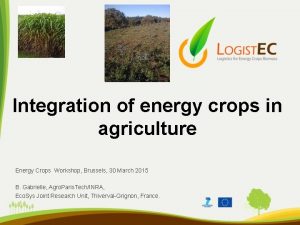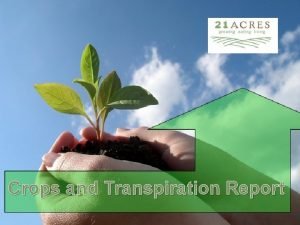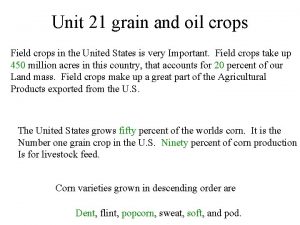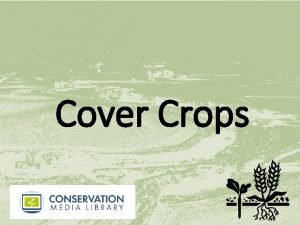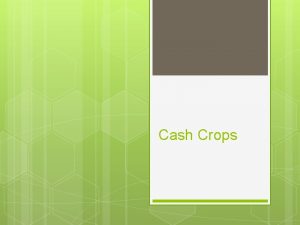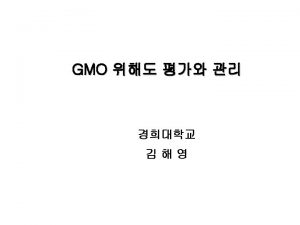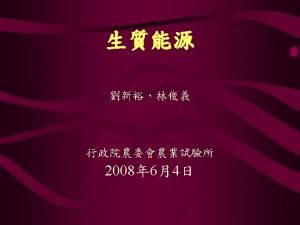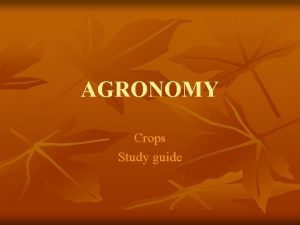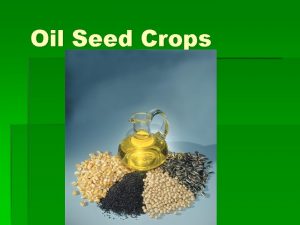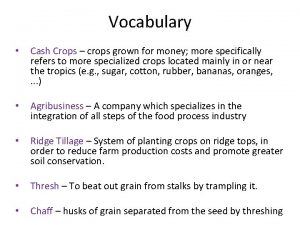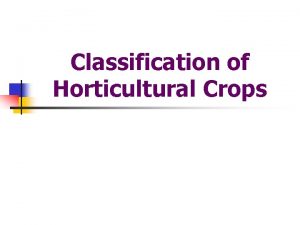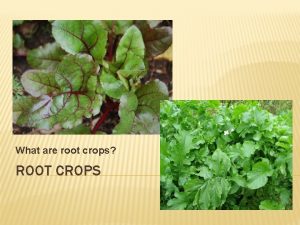Agriculture Agriculture the purposeful tending of crops and



































- Slides: 35

Agriculture


Agriculture – the purposeful tending of crops and raising of livestock in order to produce food and fiber.

Farm Facts • 2. 2 million farms dot America’s rural landscape. • Farm and ranch families – 2% • 15% - process and sell the nation’s food and fiber. • In 2010, $115 billion agricultural products were exported • Farmers and ranchers receive only 16 cents out of every dollar spent on food. The rest goes for costs beyond the farm gate: wages, production, processing, marketing, transportation and distribution. American Farm Bureau Federation 2013

Agriculture in Developed Countries • • Mixed crop and livestock farming Dairy farming Grain farming Livestock ranching Mediterranean agriculture Commercial gardening and fruit farming Access to markets- Most is land extensive and capital intensive

Wheat Farm in Montana American grain farms can cover enormous amounts of land.

World Milk Production, 2005 Fig 10 -8: Milk production reflects wealth, culture, and environment. It is usually high in MDCs, especially production per capita, and varies considerably in LDCs.

Combines on Wheat in Kansas Combines can reap, thresh, and clean crops like wheat in a single operation.

Agriculture in Less Developed Countries • Extensive Subsistence – Shifting cultivation – Pastoral nomadism – Plantation Farming • Intensive subsistence agriculture – Rice paddy – Market gardening

Shifting Cultivation in Guatemala Dense vegetation has been cut and is being burned to open land for farming.

Pastoral Nomads in Iran Qashqai nomads using paved roads to move their animals near Shiraz, Iran.

Wet Rice Terraces in Indonesia Terraces create flat land for wet (irrigated) rice on hilly land in Indonesia.

Arable Land Percent Arable by Country Does the percent of land that is arable in a country determine the agricultural output or the calorie consumption in a country?

First Agricultural Revolution 12 thousand years ago! Agriculture transformed way of life; exploited relatively small area of land intensively for given period of time (image of Ban Po, China) Challenges of New Way of Life • Dependency of fewer crops • Greater vulnerability to weather • Dependency on harvest time • Need for intense physical labor

World Areas of Agricultural Innovations Carl Sauer identified 11 areas where agricultural innovations occurred.

Vegetative Planting Hearths Fig. 10 -1: There were several main heaths, or centers of origin, for vegetative crops (roots & tubers, etc. ), from which the crops diffused to other areas. Carl Sauer suggested that Southeast Asia was a primary hearth.

Seed Agriculture Hearths Fig. 10 -2: Seed agriculture also originated in several hearths and diffused from those elsewhere.

Animal Domestication – Yay! Dogs! - Relatively few animals have been domesticated - Attempts at domestication continue, but most fail

World Regions of Primarily Subsistence Agriculture On this map, India and China are not shaded because farmers sell some produce at markets; in equatorial Africa and South America, subsistence farming allows little excess and thus little produce sold at markets.

Second Agriculture Revolution – Middle Ages through Industrial Revolution; major population explosion • A series of innovations, improvements, and techniques used to improve the output of agricultural surpluses (started before the industrial revolution). – eg. seed drill advances in livestock breeding new fertilizers

• • Von Thünen Model (1828) Spatial economics: location and land rent important are connected • What farmers produce varies by distance from the town, with livestock raising farthest from town. Maximize profit. • Concentric rings where crops dominate, transportation is a key factor 1 – highly perishable; dairy, fruit “The Isolated State” 2 – forest (fuel & building material) 3 – less perishable; field crops, grains 4 – livestock, ranching (selftransporting)

Von Thünen Model Von Thünen’s model shows how distance from a city or market affects the choice of agricultural activity in (a) a uniform landscape and (b) one with a river.

Von Thunen Model in China Lee Liu studied the spatial pattern of agriculture Found: » farmers living in a village farm both lands close to the village and far away intensively (conventional theory overlooks labor issues) » Distance from labor was more important than market or land rent » methods varied spatially – resulting in land improvement (by adding organic material) close to village and land degradation (lots of pesticides and fewer conservation tactics) farther from village.

Third Agriculture Revolution (Green Revolution) • New techniques, irrigation, fertilizers, grains and land ownership with the purpose of eliminating hunger - increased production of rice - new varieties in wheat and corn - reduced famines due to crop failure, now most famines are due to political problems - impact (in terms of hunger) is greatest where rice is produced

Average Daily Calorie Consumption per Capita

Opposition to Green Revolution • Opposition argues Green Revolution has led to: – vulnerability to pests – Soil erosion – Water shortages – Micronutrient deficiencies – Dependency on chemicals for production – Loss of control over seeds

Commercial Agriculture Term used to describe large scale farming and ranching operations that employ vast land bases, large mechanized equipment, factory-type labor forces, and the latest technology. - roots are in colonial agriculture - today, global production made possible by advances in transportation and food storage

Advances in Transportation and Food Storage - Containerization of seaborne freight traffic - Refrigeration of containers, as they wait transport in Dunedin, New Zealand

Agriculture and Climate • Climate Regions (based on temperature and precipitation) help determine agriculture production. • Agriculture Regions – drier lands usually have livestock ranching and moister climates usually have grain production.

Loss of Productive Farmland in danger of being suburbanized as cities expand into neighboring farmlands.

Agribusiness and the Changing Geography of Agriculture • Commercialization of crop production • new agricultural technologies: use of space, medicine, feeds • Poultry industry in the US: what was once concentrated production is now factory produced

Organic Agriculture • Organic Agriculture – The production of crops without the use of synthetic or industrially produced pesticides and fertilizers or the raising of livestock without hormones, antibiotics, and synthetic feeds. - sales of organic foods on the rise - grown everywhere - demand in wealthier countries

Organic Agriculture. Mapping farms in the USA

Fair Trade Agriculture • Fair Trade Coffee – shade grown coffee produced by certified fair trade farmers, who then sell the coffee directly to coffee importers. - guarantees a “fair trade price” - over 500, 000 farmers - produced in more than 20 countries - often organically produced

Fair trade coffee farmer in El Salvador grows his beans organically and in the shade, allowing him to get a much better price for his coffee.
 Tending operations in forestry pdf
Tending operations in forestry pdf Tending to persuade
Tending to persuade Active listening is focused and purposeful
Active listening is focused and purposeful Planning business messages chapter 2
Planning business messages chapter 2 Active listening is focused and purposeful
Active listening is focused and purposeful Direct and purposeful experiences
Direct and purposeful experiences Agriculture practices projects in dadra & nagar haveli
Agriculture practices projects in dadra & nagar haveli Early scarlet globe radish scientific name
Early scarlet globe radish scientific name The jumano built villages and grew crops near the
The jumano built villages and grew crops near the Gm food disadvantages
Gm food disadvantages Purposeful leadership
Purposeful leadership Affective social action example
Affective social action example Purposeful expression of feelings
Purposeful expression of feelings Purposeful leadership
Purposeful leadership Purposeful expression of feelings in social case work
Purposeful expression of feelings in social case work Daily intentional nurse leader rounding on patients
Daily intentional nurse leader rounding on patients Purposeful action examples
Purposeful action examples Labour is the purposeful process of
Labour is the purposeful process of Purposeful questioning
Purposeful questioning Listening script
Listening script Kaprekar's routine
Kaprekar's routine Purposeful expression of feelings
Purposeful expression of feelings What is purposeful movement
What is purposeful movement Offender management system
Offender management system Purposeful play definition
Purposeful play definition A purposeful refusal to become generally involved
A purposeful refusal to become generally involved Purposeful action or practice crossword
Purposeful action or practice crossword Where is athens
Where is athens What type of food did the iroquois eat
What type of food did the iroquois eat Subjective maturity indices
Subjective maturity indices What crops did ancient egypt grow
What crops did ancient egypt grow Botanical classification of vegetable
Botanical classification of vegetable Riceyness in cauliflower
Riceyness in cauliflower My crops doing well
My crops doing well Pictures of food crops
Pictures of food crops Genetically modified crops
Genetically modified crops
